|
FAQs about Hermit, Anomuran Crab Identification
2
Related Articles: Hermit
Crabs, Crabs, Marine Scavengers, Fresh to
Brackish Crabs,
Related FAQs: Hermit ID 1, Hermit IDs 3, Hermit IDs 4, & Hermit Crabs
1, Hermit Crabs 2,
Hermit Crabs 3, Hermit Behavior, Hermit Compatibility, Hermit Selection, Hermit Systems, Hermit Feeding, Hermit Reproduction, Hermit Disease/Health,
FAQs: By species: Calcinus laevimanus (Zebra, Left-handed
Hermit), Clibanarius tricolor
(Blue-Legs), Clibanarius vittatus (a
common Gulf of Mexico hermit crab), Dardanus megistos
(Shell-Breaking Reef, White-spot, Fuzzy
Leg Hermit Crab), Paguristes cadenati (Scarlet, Red-Legged),
Petrochirus diogenes
(a and other Giant Hermit Crabs), & Anemone Hermits,
Sponge/Staghorn/Coral house
Hermits, Unknown/Wild-collected,
FAQs: By species:
Calcinus laevimanus (Zebra,
Left-handed Hermit), Clibanarius
tricolor (Blue-Legs),
Clibanarius vittatus (a common Gulf of Mexico hermit crab), Dardanus megistos
(Shell-Breaking Reef, White-spot, Fuzzy
Leg Hermit Crab), Paguristes cadenati (Scarlet, Red-Legged),
Petrochirus diogenes
(a and other Giant Hermit Crabs), & Anemone Hermits,
Sponge/Staghorn/Coral house
Hermits, Unknown/Wild-collected,
& Land Hermit Crabs, Squat Lobsters, Micro-Crustaceans, Amphipods, Copepods, Mysids, Hermit
Crabs, Shrimps,
Cleaner
Shrimps, Banded Coral
Shrimp, Mantis
Shrimp, Anemone
Eating Shrimp, Marine Scavengers,
Crustacean
Identification, Crustacean
Selection, Crustacean
Behavior, Crustacean
Compatibility, Crustacean
Systems, Crustacean Feeding,
Crustacean Disease, Crustacean Reproduction,
|
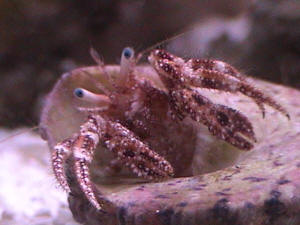 Hey there! Hey there!
|
Marine hermit crabs? ID, care -- 08/27/07
This past weekend I was in Cape Cod, MA. Some friends and I were in the
ocean (just ankle deep), and we saw a bunch of tiny hermit crabs in the
water. They are only the size of my thumb nail, maybe slightly larger.
Well of course we made the dumb decision to bring some home, and now I
have 4 of them in a water bottle with salt water and sand and rocks in
it. So far they are fine. I went to a pet store today and bought a
bunch of stuff for them. But once I got home and did more research I am
realizing to my horror that I don't think these are land hermit
crabs like I was thinking. Can I keep them in captivity or will they
die?? I bought a little plastic container and sand and a sponge for
them, but I think they need to be fully submersed in salt water
don't they?? Should I get a whole salt water aquarium system for
them?? I'm not finding much info on how to care for Marine hermit
crabs, and I'm afraid these cute little guys will be dead any day
now!!!!!! Please help!!! Thanks. Natasha (If you need a picture of them
to identify I can send one later.) <Hello Natasha. Identifying a
hermit crab to species level is very difficult without a photo. But in
the cooler parts of the North Atlantic then species of the genus
Pagurus are most common, both along the North American and European
coasts. So I'm assuming you have one of those. They are indeed
fully aquatic hermit crabs, though they are well able to tolerate
exposure to air for some time, and will scuttle about in very shallow
water even with half their bodies exposed. But for long term care you
will need to set them up a "coldwater marine" aquarium. This
is not difficult. Firstly, you'll need a tank around the 10 gallon
mark. Then you'll need a filter. I'd recommend a simple
air-powered box filter filled with ceramic media and a bit of filter
wool. There's no need for carbon or anything else. The aquarium
needs to be filled with artificial seawater -- that is, water with
about 35 grammes of *marine aquarium salt mix* added per litre of
water. Using a hydrometer you need to aim for a specific gravity of
about 1.027 at 18 degrees C, the maximum safe temperature for these
crabs. Try and keep them cooler if you can. I have a little program
called 'Brack Calc' on my web page (
http://homepage.mac.com/nmonks/ ) that lets you relate the
required salinity (35 g/l) with whatever temperature you have and the
specific gravity you can directly measure. Beyond this, keeping hermit
crabs is easy as they are quite hardy and adaptable. They are
omnivores, mostly feeding on algae, organic detritus, and carrion. In
the aquarium almost anything will be accepted, from algae pellets to
raw seafood. Don't overfeed them though. Apart from the fact these
animals don't need extra light and don't like warmth, in terms
of basic care they are otherwise similar to tropical marine hermit
crabs. Hope this helps, Neale>
Hermit Crab Possible Misidentification
8/19/07 * First let me say that your site really is great. When I
buy aquarium books, I look for your names, period. Concerning this
email, I would appreciate a response, but it need not be public
(although I don't mind if it is). <We post all> I believe the
photo in "Hermit Crabs, Use in the Marine Aquarium Hobby"
(http://wetwebmedia.com/marine/inverts/arthropoda/crabs/hermitcrabs.htm)
labeled *Phimochirus *[aka *Pylopagurus*]* holthuisi* (Provenzano,
1961), Red-striped Hermit, is really *Clibanarius vittatus* (Bosc,
1802), Thinstripe Hermit. * <Have tried to look just now... via
Google mostly... to discern... Humann, does state that the Red-Stripe
Hermit has "one claw greatly enlarged... movable pincer is
white"... which in viewing the original (aquarium) image of mine
is obviously not the case...> My reasons: 1. Color and Markings:*
The photo you have in "Hermit Crabs, Use in the Marine Aquarium
Hobby"
(http://wetwebmedia.com/marine/inverts/arthropoda/crabs/hermitcrabs.htm)
looks nothing like the photo in
http://www.gsmfc.org/seamap/picture_guide/Hermit%20Crabs/phimochirus%20holthuisi.pdf,
but does look like the photo in
http://www.gsmfc.org/seamap/picture_guide/Hermit%20Crabs/clibanarius%20vittatus.pdf
.* 2. Claws:* Even if the photos were of such poor quality that color
and markings were not reproduced well, notice the one huge claw of *P.
holthuisi*, and the matched claws of *C. vittatus*. I do not think the
one crab in your photo just happened to have matched claws at that
point in time because I have seen many photos on the web that are
*supposed* to be *P. holthuisi*, and all of them with the same
longitudinal stripes on the legs also have matched claws. Obviously,
these photos are incorrectly labeled, also.* 3. Habitat:* *P.
holthuisi* is "Found on shell, sand, mud and coral bottoms from 15
to 104 m." *C. vittatus* is "Common on harbor beaches and on
borders of mud flats; rock jetties; water line to 22 m." Perusal
of the web (your site and others) indicates that people who find hermit
crabs looking like your *P. holthuisi* photo have found these guys very
near the waterline, definitely not 15 m below it. * Elsewhere on Your
Site * Some confusion in general: Note the entry in "FAQs about
Hermit Crab Identification",
http://www.wetwebmedia.com/hermitidfaqs.htm: * Re: hermit crab question
8/1/06 *Thanks for your patience. I believe that they are red striped
hermit crabs. <Clibanarius vittatus?> * Spread to the Web *
Interestingly enough, I believe the misidentification has spread to
others on the web. You guys have a very powerful site! The whole thing
is becoming circular. E.g., <Yes... perhaps too powerful... and
circular...>
http://www.saltcorner.com/sections/zoo/inverts/crustaceans/hermitcrabs/Pholthuisi.htmhas
Bob Fenner's picture of (what I contend is) *C. vittatus*. It is a
higher resolution photo of the one on your site, so people can more
easily (incorrectly) identify their hermit crabs. <Will post today
as our "daily pic"... Am assured here that your ID is
correct> * Recommendation * If I am correct, I think you should at
least do #1. 1. In "Hermit Crabs, Use in the Marine Aquarium
Hobby" ( http://wetwebmedia.com/marine/inverts/arthropoda/crabs/hermitcrabs.htm),
either change the picture or change the description. As you have
pointed out elsewhere, *C. vittatus* does get rather large, 10 cm at
least (Adam J. said he had one (actually, he said it was *P. holthuisi*
in a 6" shell). 2. Add *C. vittatus* to your list of hermits. 3.
You might want to go through the references to *P. holthuisi* and
correct whatever was said about them. Thanks for considering this,
Scott Allen Rauch -- Scott <Thanks much for this Scott... will
addend/fix today. Sending notes to récif et al is going to
be a bit more extracted task. Cheers, Bob Fenner>
Atlantic Hermit Crab ID -- 06/20/07 Good
morning, <<Hello Jason>> I picked up (literally) this
hermit in Myrtle Beach over the weekend. <<Ah!...is about a
3-hour commute from my home here in Columbia>> He was in
about 3-feet of water during low tide. He's currently in my QT
and is doing fine. He's even eating a few pellets daily.
<<Mmm, yes...voracious appetites>> He isn't very
active during the day, but he's all over the place at night.
He's quite quick too--look at those long legs! <<I see
them...>> Do you have any idea what he is, or if he's
reef safe? <<I believe what you have is Pagurus longicarpus
or the Long-claw Hermit Crab. These are quite common along the
Mid-Atlantic coast. It is a small crab and appears primarily to be
a detritus feeder, but this hardly means it will prove reef-safe.
But for the mostly commensal 'Acro' crabs (and these even
bear watching, occasional removal) I don't put 'any'
crabs in my system as they are too 'opportunistic' in their
feeding behavior for my liking. If you like/find the crab
interesting you can give it a try but keep a close eye out for
problems. Also...as a temperate to sub-tropical species, placing in
a tropical marine system will likely shorten its life-span>>
Jason
<<Happy to share. EricR>> |
|
Re: Atlantic Hermit Crab ID - 06/20/07 Thank
you. <<Quite welcome>> I will probably place him in
my sump or 'fuge to be on the safe side. Thanks,
Jason
<<Regards, EricR>>
|
|
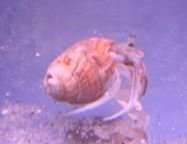
|
ID of Hermit needed please: Dardanus
megistos 3/31/07 Hi, <Hi Wikus, Mich here.>
Could you positively ID this crab for me please? I bought it a
Clibanarius tricolor, but to be honest, it does not look like the
pics I have seen. <Yeah... no, definitely not a Clibanarius
tricolor. Looks like a Dardanus megistos, which is not
reef safe, is highly aggressive and predatory and can get up to
11.7 inches!!! Many thanks
<Welcome! Mich>
Wikus |
|
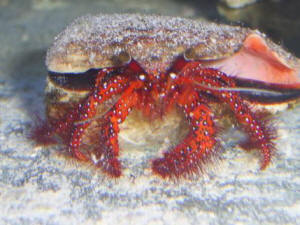
|
| Hermit crab identification - 03/24/07
Any chance you can ID this crab? I placed an order online, and this
crab came in with the Nassarius snails I ordered, complete with
Nassarius snail shell. It is devilishly quick. It scuttles left and
right rather than forward. I am not sure if that helps. It has a
sand colored appearance also. I currently have it residing in my
sump, in a container with a mesh top so it won't escape. It is
only 1/4-1/2". Thought or suggestions as to what I can do with
it? <Enjoy it> If it wasn't going to hurt anything I was
going to let it loose in the sump. Would it take out my pods I have
in their or would it focus on detritus? <No way to tell, but
I'd leave it there> If I put him in there should I add
several empty shells? <A few would be a good idea> Thanks for
the help! Brian <Mmm.... Might be Dardanus deformis... a/the
"Rock Hermit Crab"... can get a bit too large... http://images.google.com/images?q=Dardanus%20deformis&rls=com.microsoft:en-us:IE-Address&ie=UTF-8&oe=UTF-8&sourceid=ie7&rlz=1I7PCTA&um=1&sa=N&tab=wi
Bob Fenner> |
|
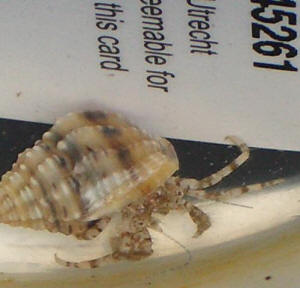
|
Mystery Hermit 2/11/07 Hello, <Hey.> You
guys run a great website that I use often. <Great.> However I
have looked all over the sight to try to identify this hermit crab that
I got in a group of dwarf blue hermits. He is a green color with a
single vertical stripe going down each leg with white spots on his
claws. <Oohh sounds like Phimochirus holthuisi, I too
received a juv. mixed in with some other hermits once.> he looks
very similar to the dwarfs hermits. The color of the green
is similar to that of an emerald crab. Sorry that I
can't get a pic for you right now, I loaned my camera to a friend.
<Google the name I gave you above, I willing to bet that's your
crab.> I am worried that he might not be reef safe any ideas?
<Mmm....the problem with the crab I named is not so much that he
attacks sessile invertebrates but that it attains a rather hefty size
and becomes a little clumsy.> So, far I haven't seen him going
for corals or anything yet but he is only maybe 3/4 in shell included.
Thanks for the help. <Anytime.> Steve
<Adam J.>
| Hermit crab identification
1/16/07 Hello and thanks for reading my email. I
unwittingly brought home a resident of what I thought was an empty
shell from vacation. (How many hundreds of times do you
hear this?!) <A bunch... even done it myself a few dozen
times...!> A week after returning home, I was
oiling some of the shells when one of them started moving in the
collection box--woops! They certainly must be resilient
little critters. <Oh yes> I've been searching online for
information, and have learned that marine, land and
"hybrid" hermit crabs all need very different care.
<Yes... there are terrestrial, amphibious all the way to
completely marine species> He/she has been nearly entirely
hidden in his/her shell, but I read that holding the shell in the
warmth of your hand might bring them out, and it
did. I'm attaching a couple of pictures I took in
hopes that you can help me identify this fella. I would
gladly return him to his home beach, but I'm 1000 miles away.
Sally Stephenson Frostburg State University Frostburg MD (nowhere
near the ocean) <Yikes... yellowish eye stalks, bluish eyes,
striped legs... see it here: http://wetwebmedia.com/marine/inverts/arthropoda/crabs/hermitcrabs.htm?
Bob Fenner> |
Re: hermit crab identification
1/17/06 Most closely resembles Phimochirus holthuisi to me,
what little of him I've seen. Does that mean he
should be completely submerged in appropriately salty water, or
does he need a "land" area as well? <This is an
entirely aquatic species: http://www.gsmfc.org/seamap/picture_guide/Hermit%20Crabs/phimochirus%20holthuisi.pdf>
Is temperature critical? <That it be stable... yes> The pet
store gave me shrimp pellets, but so far he's shown no interest
in them. Thanks,
Sally
<Read my friend. Bob Fenner> |
|
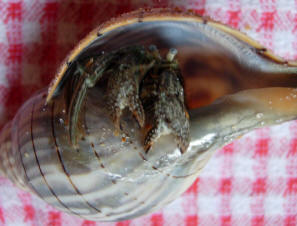 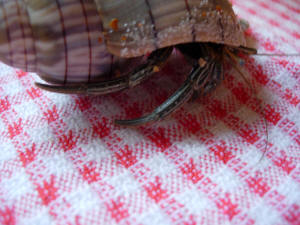
|
| Aquatic Hermit crab identification
10/26/06 Greetings, <Salutations> Recently I have become
quite interested in aquatic Hermit Crabs, and I have been doing
quite a bit of digging for information on them. It seems there is
very little information on them available, outside of WWM.
<Mmm... bunches of non-husbandry information re these anomurans
in large libraries> I have also managed to pick up a few oddball
Hermits from my LFS, which I have not been able to identify for the
life of me. I've Googled, and I've Googled, and I've
Googled.... <Not Google-able presently> But to no avail, I
have not been able to ID them. Either I am not good at searching
for things on google, or the photos/information are extremely hard
to find/non-existent. <Just not
ready-referenced> I have included the pictures of the oddballs
on this e-mail. I was hoping you guys could help ID them? I've
included 5 pictures of 3 different types of unidentified hermits,
labeled "A", "B", and "C". More pics
on the way as well, I've got 2 others that I can not ID, but
they are hard to photograph. Once I have gathered enough info and
gained enough experience, I am considering starting a webpage for
aquatic hermit crabs. There just doesn't seem to be any one
webpage with enough info, pictures, and scientific names. Oh, and
if Bob Fenner is reading this, you may remember me from IMAC! I was
one of the puffer guys, and we also talked over e-mail a bit in the
past. Regards, -John <Ahh! Pleased to make your re-acquaintance.
Can't recall from my feeble memory what these might be... do
"practice" setting them up on a rock... waiting patiently
for their re-emergence to photograph with a bit more detail... and
send along again. Bob Fenner, out away from references... in
Thailand> |
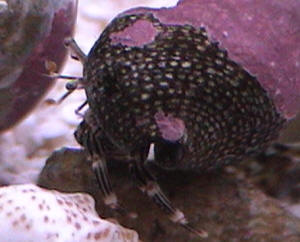 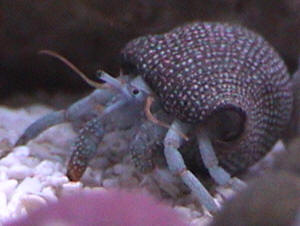 |
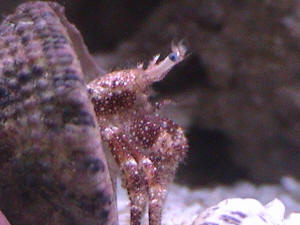  |
|
|

